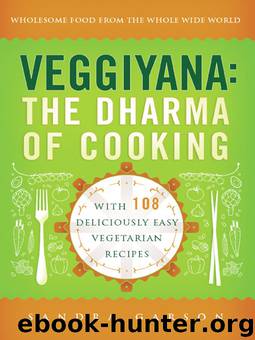Veggiyana by Sandra Garson

Author:Sandra Garson
Language: eng
Format: epub
Publisher: Wisdom Publications
Published: 2011-09-14T16:00:00+00:00
Everything you see I owe to spaghetti.
—SOPHIA LOREN
Noodles: “Boiled Bread”
AFTER LIBERATING NAPLES from foreign monarchy in 1860, Giuseppe Garibaldi supposedly turned to his aides planning Il Risorgimento and said: “It is macaroni, I swear to you, that will finally unite Italy.” He was not joking. For more than two thousand years, with remarkable consistency even in the guises of diverse names in divergent languages, the Arabic al-fidawsh (“burst open like a bud”), Italian vermicelli (“little snakes”), and Hindi lakhshah (“slippery”), noodles have transcended cultural, geographical, and political boundaries, uniquely bringing far-flung, sometimes feuding residents of the planet to the table in absolute agreement on at least one important point: mmm...good!
Perhaps the greatest testament to the universal adoration of noodles is not how wide they’re spread over the map, but the ongoing competition for the honor of being their creator (China, Italy, the Arabs?), even though the most likely parents of the whole caboodle lived around the Tarim Basin. The Central Asian steppes have historically been a perfect place to grow wheat, with plenty of rivers to add water. Auspiciously, for millennia they also happened to be the bustling intersection of crisscrossing civilizations always on the lookout for something tasty.
The union of flour and water was momentous. Mother Nature’s handout, wheat berries, had originally been boiled into porridge, fermented for beer, cracked, or eventually cooked until they burst, at which point they were dried to create bulgur. Then the Iron Age brought the grindstone and suddenly the world was filled with flours. The inspired combination of ground wheat and water to make a paste (hence the word pasta) was such a succes fou that caravans and nomads carried their own grindstones, even though oases on the Silk Road proudly featured them. Where there was fuel to heat ovens, a ball of paste or dough was flattened and slapped on the inside wall to make thin bread like naan, roti, lavash, or pita. On the steppes, where there were no trees and thus no fuel, flattened balls of dough were cleverly stretched and sliced into thin strips that could be dunked into hot broth or water. It was thought of as “boiled bread.” Lagman, fettuccini-like noodles in hot lamb broth with a name redolent of both lasagna and lo mein, has been a dietary staple of the chilly Central Asian region since at least 300 BCE when a Han Chinese intellectual mentioned it in his ode to pasta. Lagman is still served by Uighers, while the rest of us have a world of wannabes: Vietnamese pho, Indonesian bakso, Thai khao soi, Tibetan thukpa, Korean ramyeon, ramen (originally imported to Japan from China in soup), Malaysian laksa, Burmese mohinga, Hawaiian saimin, and chicken noodle in a can. In Asian Noodles, Nina Simonds says a bowl of noodle soup has become the world’s premier comfort food. In his autobiography Freedom in Exile, the only event the Dalai Lama fondly recounts from the precarious days of his first escape to India is the journey “by train with my small entourage to Calcutta.
Download
This site does not store any files on its server. We only index and link to content provided by other sites. Please contact the content providers to delete copyright contents if any and email us, we'll remove relevant links or contents immediately.
Biscuits: A Savor the South Cookbook by Belinda Ellis(3905)
Al Roker's Hassle-Free Holiday Cookbook by Al Roker(3177)
A Jewish Baker's Pastry Secrets: Recipes from a New York Baking Legend for Strudel, Stollen, Danishes, Puff Pastry, and More by George Greenstein(3103)
Ottolenghi Simple by Yotam Ottolenghi(3038)
Trullo by Tim Siadatan(2987)
The French Women Don't Get Fat Cookbook by Mireille Guiliano(2983)
Better Homes and Gardens New Cookbook by Better Homes & Gardens(2953)
Bake with Anna Olson by Anna Olson(2931)
Panini by Carlo Middione(2827)
Hot Thai Kitchen by Pailin Chongchitnant(2809)
Nigella Bites (Nigella Collection) by Nigella Lawson(2773)
Momofuku by David Chang(2763)
Modern French Pastry: Innovative Techniques, Tools and Design by Cheryl Wakerhauser(2724)
Salt, Fat, Acid, Heat: Mastering the Elements of Good Cooking by Nosrat Samin(2658)
Tapas Revolution by Omar Allibhoy(2534)
Classic by Mary Berry(2501)
Solo Food by Janneke Vreugdenhil(2491)
Best of Jane Grigson by Jane Grigson(2468)
Okonomiyaki: Japanese Comfort Food by Saito Yoshio(2389)
